Body length: 9–26 mm.
Eyes: eye interommatidial setaeseta:
a sclerotized hair-like projection of the cuticle
absent, eye entire/shallowly emarginateemarginate:
notched at the margin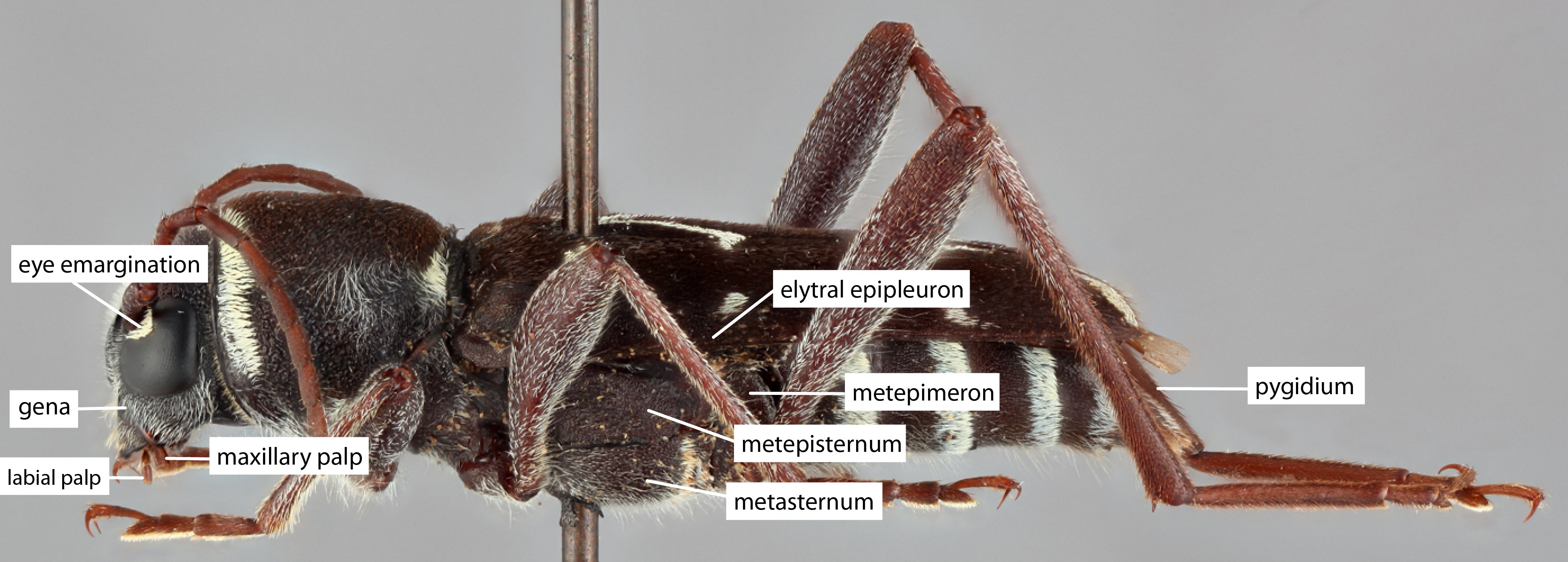 , eye ommatidial density fine.
, eye ommatidial density fine.
Antennaeantenna:
in larval and adult insects, paired segmented appendages, borne one on each side of the head, functioning as sense organs and bearing a large number of sensilla
: antennal length barely surpassing pronotumpronotum:
the upper and dorsal part of the prothorax
or shorter or reaches between basebase:
the part of any appendage or structure that is nearest the body
and end of elytraelytron:
the leathery forewing of beetles, serving as a covering for the hind wings, commonly meeting opposite elytron in a straight line down the middle of the dorsum in repose
, antennal flagellar segments elongateelongate:
much longer than wide
, quadrate or transversetransverse:
broader than long
, scapescape:
the first proximal segment of the antenna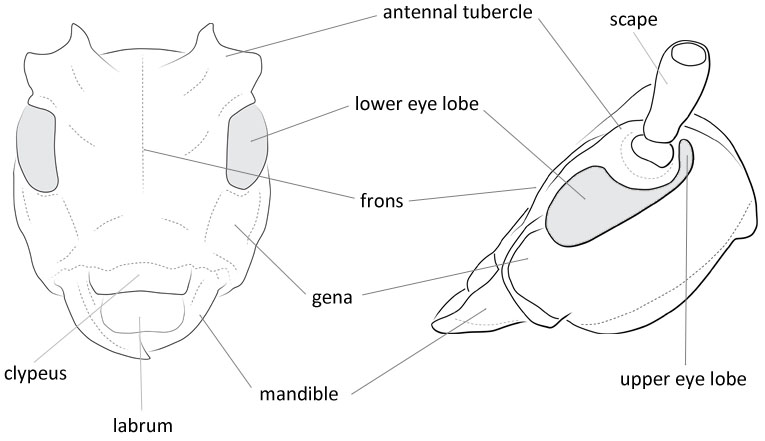 smooth/punctate at apexapex:
smooth/punctate at apexapex:
end of any structure distad to the base
, antennal scapescape:
the first proximal segment of the antenna ≥ segment 3.
≥ segment 3.
Pronotumpronotum:
the upper and dorsal part of the prothorax
: pronotumpronotum:
the upper and dorsal part of the prothorax
shape transversetransverse:
broader than long
or subquadratesubquadrate:
not quite a square
, pronotumpronotum:
the upper and dorsal part of the prothorax
lateral armature acute spinespine:
a protuberance with an acute (sharp) distal end
.
Prosternum: prosternal processprosternal process:
a posterior extension of the prosternum between the coxae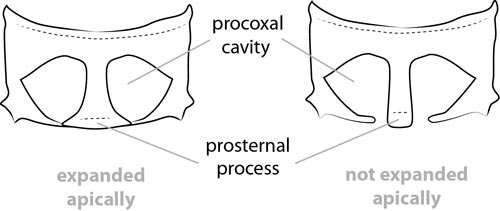 dilated at apexapex:
dilated at apexapex:
end of any structure distad to the base
, procoxal cavities closed posteriorly.
Elytraelytron:
the leathery forewing of beetles, serving as a covering for the hind wings, commonly meeting opposite elytron in a straight line down the middle of the dorsum in repose
: elytral length reaching or close to end of abdomen, elytral apicesapex:
end of any structure distad to the base
rounded or truncatetruncate:
cut off squarely at the tip
, elytral color pattern present.
Legs: visible tarsomerestarsomere:
subdivision or article of the tarsus, usually numbering from two to five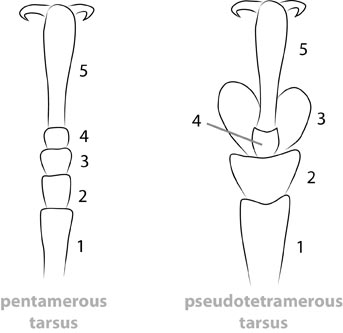 : 4, femora slender, protibial spursprotibial spur:
: 4, femora slender, protibial spursprotibial spur:
sclerotized spine(s) located at the distal tibia; can be single, double, or absent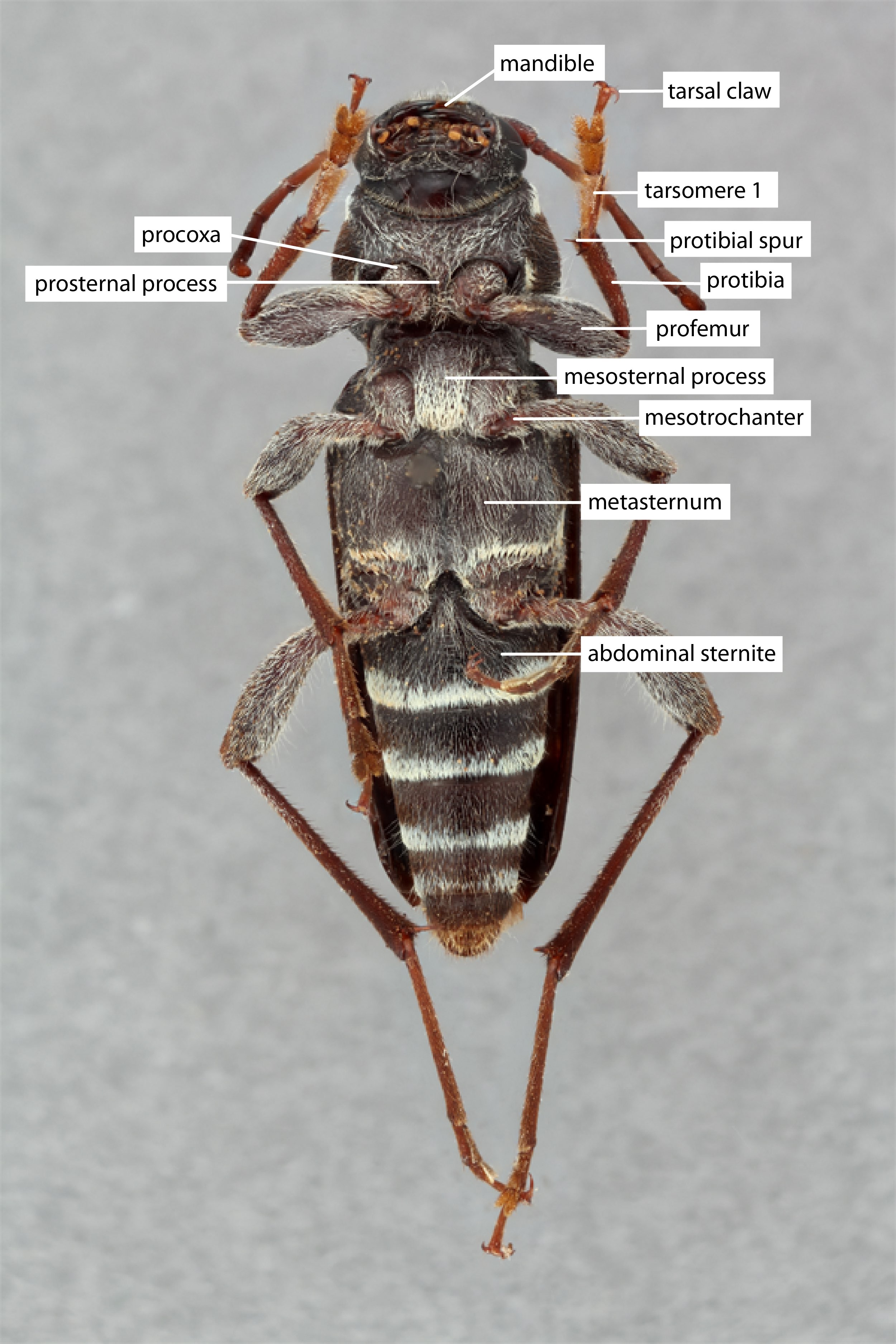 : 2, tarsal clawstarsal claw:
: 2, tarsal clawstarsal claw:
usually paired claws of the pretarsus, at the distal end of the leg simple.
simple.
Form moderate-sized to stout, sides subparallel. Head oblique, constricted behind prominent tempora, neck not dorsally grooved; antennaeantenna:
in larval and adult insects, paired segmented appendages, borne one on each side of the head, functioning as sense organs and bearing a large number of sensilla
short, seldom extending beyond basebase:
the part of any appendage or structure that is nearest the body
of elytraelytron:
the leathery forewing of beetles, serving as a covering for the hind wings, commonly meeting opposite elytron in a straight line down the middle of the dorsum in repose
, Inserted between eyes at lower margin, insertions narrowly separated, segments 5 to 11 enlarged; eyes finely faceted, very shallowly emarginateemarginate:
notched at the margin ; palpi unequal, apicesapex:
; palpi unequal, apicesapex:
end of any structure distad to the base
dilated. Pronotumpronotum:
the upper and dorsal part of the prothorax
strongly, acutely tuberculate laterally, disk variable; prosternum strongly impressed; intercoxal process broad, protuberantprotuberant:
rising or produced above the surface or general level
between coxae, abruptly declivous behind, apexapex:
end of any structure distad to the base
not dilated, coxal cavities almost closed behind; mesosternum with intercoxal process usually protuberantprotuberant:
rising or produced above the surface or general level
, abruptly declivous in front: epistemum of metathorax fairly narrow, tapering posteriorly. Elytraelytron:
the leathery forewing of beetles, serving as a covering for the hind wings, commonly meeting opposite elytron in a straight line down the middle of the dorsum in repose
strongly costate, subparallel-sided; wings with an anal cell. Legs moderately stout, femora gradually enlarging; posterior tarsitarsus:
the leg segment distal to the apex of the tibia, bearing the pretarsus; consists of one to five tarsomeres (including pretarsus)
moderately broad, first segment as long as following two together, third segment cleft to basebase:
the part of any appendage or structure that is nearest the body
. Abdomen usually carinate medially (Chemsak 2005Chemsak 2005:
Chemsak JA. 2005. Illustrated Revision of the Cerambycidae of North America. Volume II. Lepturinae. Wolfsgarden Press, Chino, CA: i–xv + 1–446, 27 pls.).
The short antennaeantenna:
in larval and adult insects, paired segmented appendages, borne one on each side of the head, functioning as sense organs and bearing a large number of sensilla
, strongly produced lateral margins of the pronotumpronotum:
the upper and dorsal part of the prothorax
, and strongly costate elytraelytron:
the leathery forewing of beetles, serving as a covering for the hind wings, commonly meeting opposite elytron in a straight line down the middle of the dorsum in repose
will readily distinguish Rhagium among the Lepturinae (Chemsak 2005Chemsak 2005:
Chemsak JA. 2005. Illustrated Revision of the Cerambycidae of North America. Volume II. Lepturinae. Wolfsgarden Press, Chino, CA: i–xv + 1–446, 27 pls.).
Palearctic, Nearctic
Abies, Pinus, Picea, Larix, Pseudotsuga, Tsuga; Taxodiaceae: Cryptomeria; Cupressaceae: Chamaecyparis; broadleaf trees
9 species and 5 more sspp. In subgenus Rhagium; 1 sp. Hagrium; 9 spp. Megarhagium. R. inquisitor is Holarctic. Conifers: Rhagium (Rhagium) femorale, R. (R.) heyrovskyi, R. (R.) inquisitor, R. (R.) japonicum, R. (R.) morrisonense, R. (R.) pseudojaponicum, R. (Hagrium) bifasciatum, R. (Megarhagium) mordax.
Stenocorus Geoffroy, 1762 [ICZN opinion] [for Rhagium]
Hargium Samouelle, 1819 [for Rhagium]
Allorhagium Kolbe, 1884 [for Rhagium]
Rhagium (Hagrium) Villiers, 1978 [part] [for Rhagium]
Subgenus Rhagium Fabricius, 1775
Subgenus Hagrium Villiers, 1978
Subgenus Megarhagium Reitter, 1912